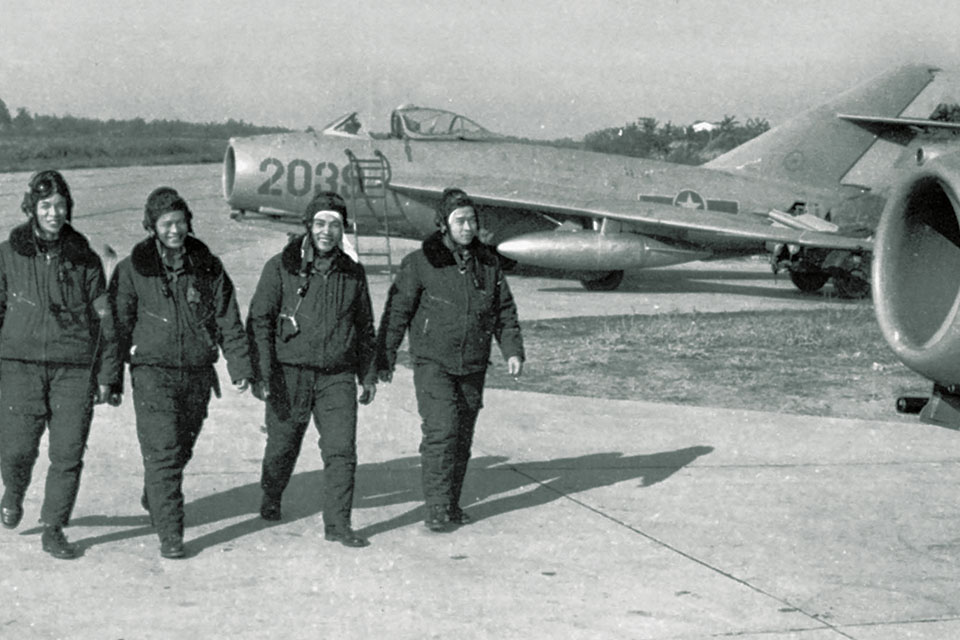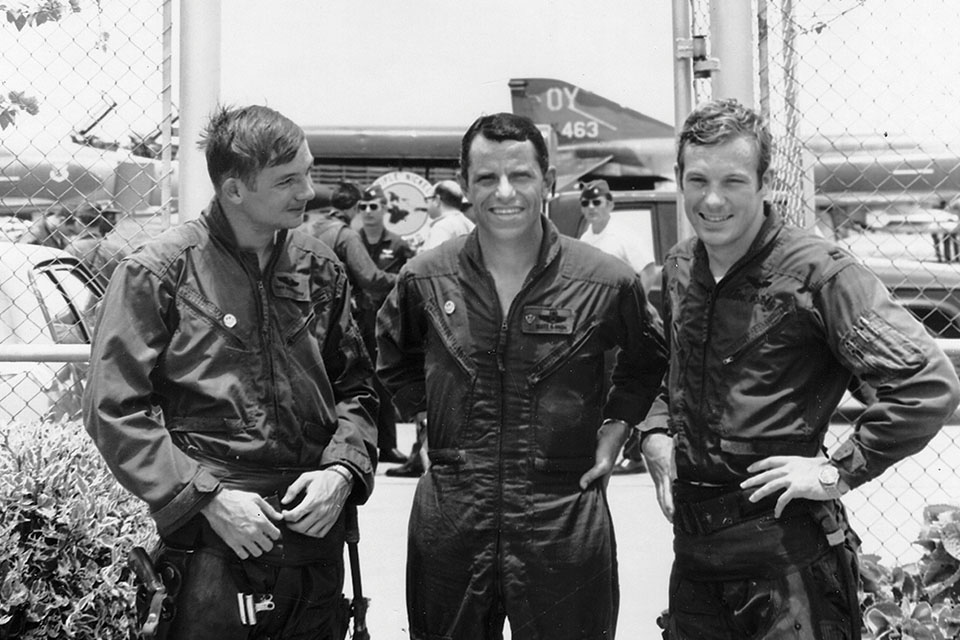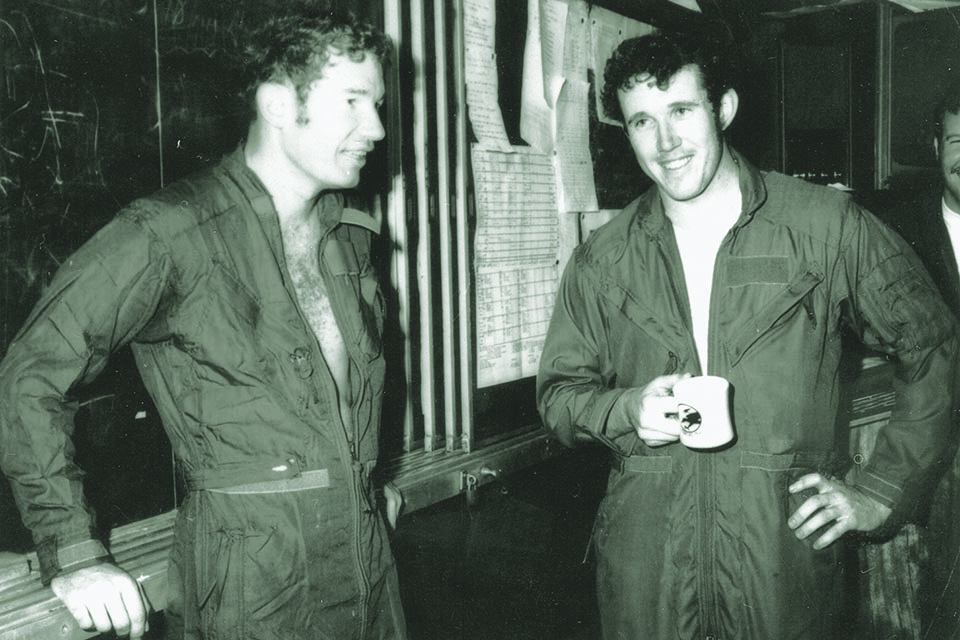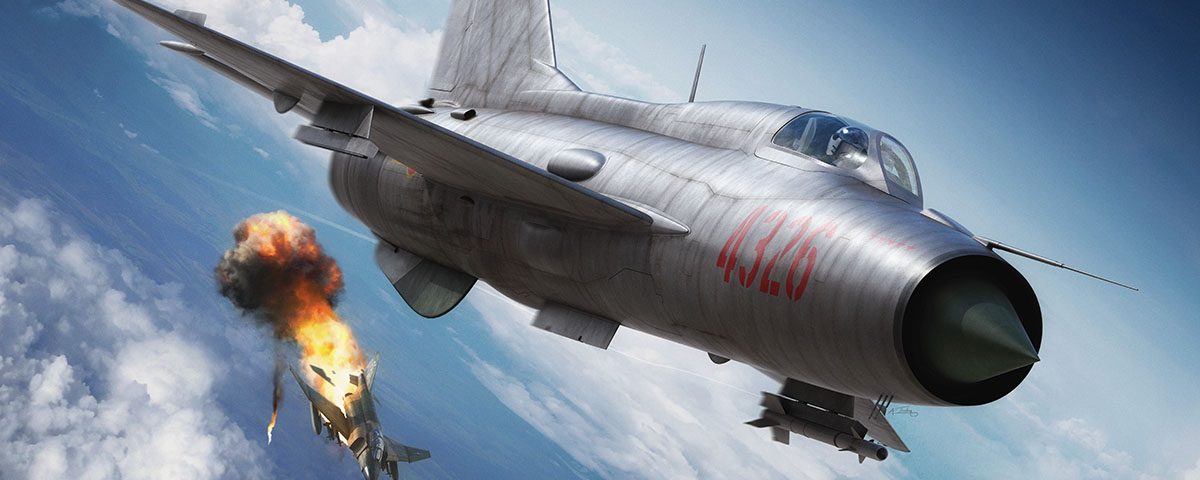Before Pham Thanh Ngan became the first ace of the Vietnam War, 11 other pilots had claimed the same status
Two U.S Air Force F-102 Delta Daggers from the 509th Fighter Interceptor Squadron were escorting an EB-66C radar-jamming aircraft over the Laotian border, about 90 miles southwest of Hanoi on Feb. 3, 1968, when flight leader Maj. A. L. Lomax got a report from his wingman, 1st Lt. Wallace Wiggins. The lieutenant’s aircraft was acting abnormally. Lomax took a look and was shocked to see part of a Soviet-made R-3S air-to-air missile embedded in the aft fuselage of Wiggins’ F-102. As the two Delta Daggers beat a hasty retreat home, Lomax spotted a pair of North Vietnamese MiG-21s behind them. He turned and fired three AIM-4 Falcon missiles—without effect. He then saw his wingman’s jet engulfed in flames, likely the result of the original missile strike. Wiggins was killed in the explosion.
The victorious communist pilot was Pham Thanh Ngan, who had just become the first ace of the Vietnam War. However, Ngan didn’t know he was first because no fewer than 11 North Vietnamese pilots had already mistakenly or falsely claimed that status during the previous 13 months. Indeed, even Ngan had undeservedly made such a claim earlier.
Since the beginning of aerial warfare, fighter pilots have sought the title of “ace,” bestowed on aircrews that have at least five confirmed victories. During both world wars, many aces ran up dozens, sometimes hundreds, of kills.
However, with the advent of jet fighters—first tested in 1950 during the Korean War—aerial victories became more elusive, in part because the increased speed enabled pilots to better evade the enemy’s fire. In the three years of the Korean War, the highest-scoring American ace, Air Force pilot Joseph McConnell, had just 16 victories, while the top enemy ace, Soviet pilot Nikolai Sutiagin, claimed 22, a total almost certainly falsified. Ironically, to justify such lofty claims, the Russians allege that the U.S. Air Force extensively falsified its loss records by underreporting the number of American planes shot down.
In Vietnam, it took three-and-a-half years for Ngan to become the first true ace, an additional four and a half for the second North Vietnamese ace to emerge and eight years for the U.S. to get its first aces.
The most comprehensive chronicles of North Vietnamese aces are the works of István Toperczer, a Hungarian flight surgeon, who interviewed North Vietnamese pilots and pored over all available documentation. Toperczer approached the subject with a fairly even hand—in contrast to earlier writers. He has not been completely consistent across his books, however, with some credits going to one pilot in one volume and the same credit being attributed to another pilot in a different book, which could mean his later works reflect more complete research and are therefore more authoritative.
Unfortunately, Hanoi has never published its official records on the Vietnam War, as its archivists still consider much of them classified. Toperczer clearly has been granted unprecedented access to North Vietnamese air force records, and his five monographs, with their wealth of information on the North Vietnamese air force, are the closest thing to an official Vietnamese account. But until Vietnamese records are widely available for analysis, it is unlikely we will be able to piece together the true and complete story of what happened in the skies over North Vietnam.
Another way to judge the validity of North Vietnamese claims is to correlate them with the records of U.S. losses based on tail numbers and other data in a comprehensive postwar Air Force study of aerial combat in Southeast Asia, called the “Red Baron Reports.”
All efforts to separate the wheat from the chaff in the North Vietnamese claims face the same challenge: Aerial combat can be very confusing. Studies show that the victor in a dogfight is most often the pilot who can maintain a clear picture of the three-dimensional battle space in real time. Thus, even when we have access to painstakingly reconstructed accounts, we may be looking at reports with an inadvertently false portrayal of what happened in the sky, making it difficult to authoritatively determine what actually occurred during combat.
Additionally, enemy aircraft types are often confused and even judgments on what weapons caused the damage can be in error. For example, Navy ace Lt. Randall “Duke” Cunningham was adamant that his aircraft was brought down by a North Vietnamese SAM, a surface-to-air missile, at the end of his final mission on May 10, 1972. However, there is solid evidence to suggest that he was shot down by a North Vietnamese MiG-21 piloted by Vu Duc Hop. (Cunningham and the plane’s other crewman, Lt. j.g. William Driscoll, ejected into the South China Sea and were picked up by helicopter.)
An analysis of currently available data leads to the conclusion that North Vietnam, which touted at least 20 aces during the war, produced just three. In comparison, the U.S. produced five aces—three Air Force, two Navy. In the American count, both men in an F-4 Phantom II fighter-bomber, the plane flown by all of the U.S. aces, got credit for a shootdown. Therefore, a two-man crew earning five kills would be counted as two aces.

North Vietnam fielded Soviet-made MiG-17 fighters from the beginning and added MiG-21s in April 1966. No communist pilots became aces flying only MiG-17s. American aircrews ran up a strong 4.3-1 kill ratio against the MiG-17.
In their dogfight on May 10, 1972, pilot Cunningham and radar-intercept officer Driscoll shot down three MiG-17s to become the first American aces of the war. However, one MiG-17 pilot fought those two Americans so well that day that he very nearly turned the tables on Cunningham and Driscoll, but the communist met his fate when he ran low on fuel and was forced into a doomed run for home. That day in May 1972 Air Force and Navy crews shot down seven MiG-17s and four MiG-21s. After those losses, the North Vietnamese pulled the obsolescent MiG-17s out of active combat.
One of the North Vietnamese aces got his victories in 1967 and 1968 during Operation Rolling Thunder; the other two aces, during Operation Linebacker I in 1972.
All of their victories occurred after the introduction of new (and highly successful) MiG-21 tactics in late August 1967. This technique, which the North Vietnamese variously labeled “fast attack-deep penetration” or “fast attack-fast withdrawal,” used ground-controlled radar to locate incoming American aircraft and position MiG-21s above and behind them, allowing those communist interceptors to dive at supersonic speed, launch missiles and make a fast escape to safety.
U.S. Air Force commanders found these tactics particularly difficult to counter because they lacked good radar warning systems across inland areas, while the North Vietnamese had excellent radar coverage and room to gain favorable positioning.
The new MiG-21 tactics clearly improved the performance of North Vietnamese pilots, but Hanoi exaggerated their successes. When a gun camera records a wing torn off an aircraft or a pilot ejecting, there is no doubt the attacker has a valid claim, but some 24 percent of North Vietnam’s claimed 134 shootdowns involved American aircraft demonstrably not lost under the claimed circumstances, and a further 19 percent were made on days when no U.S. aircraft were recorded lost over North Vietnam. An additional 17 percent were credits awarded for shooting down Ryan “Firebee” reconnaissance drones—robot jet aircraft originally designed as aerial targets. Thus 60 percent of the North Vietnamese claims were invalid.
Some of the invalid claims are undoubtedly innocent mistakes, but only a small percentage. If a pilot claims a kill but no aircraft was lost that day, that’s difficult to forgive. It’s likely some false claims were part of a deliberate strategy by the North Vietnamese government.

Hanoi was locked in a long struggle in which a sophisticated use of propaganda and misinformation was believed (correctly, as it turned out) to be a decisive strategic weapon. One of the communist leadership’s major objectives was to demoralize the American public and government by miring them in a war they would come to see as unwinnable. If American pilots who achieved astronomical kill ratios against enemy pilots in the Korean War were unable to repeat their success over North Vietnam, that would add to the bleak outlook for America that Hanoi was trying to cultivate
Therefore, a good number of invalid claims apparently were engineered by Hanoi’s propagandists to produce fictitious “aces” in support of their war aims. In many cases, it seems as though they were even willing to “steal” credits from anonymous SAM and anti-aircraft gun crews to bolster their fighter pilots’ claims.
Meanwhile, the U.S. failed to produce any aces until the final months of American military involvement, so the ever-present images of North Vietnamese “aces” on the pages of newspapers throughout the communist world—and even in the media of some erstwhile U.S. allies—have been an irritant to American air power advocates to this very day.
Even so, Hanoi’s numerous incidences of demonstrably inflated claims shouldn’t distract from the real success of some North Vietnamese airmen. While the average North Vietnamese pilot was arguably less skilled than his American counterpart, North Vietnam still produced—under unenviable circumstances—pilots who could fly with the best that any nation could offer. Certainly, North Vietnam’s three confirmed aces were men of exceptional skill. The non-ace MiG-17 pilot who fought U.S. aces Cunningham and Driscoll to a standstill—and probably could have defeated them had he a better mount—puts the exclamation point on that judgment.
Sometimes a rumor can take on a life of its own. Such was the case with the North Vietnamese Air Force’s “Col. Tomb,” a mythical ace with 13 victories who met his fate in the dogfight that made U.S. Navy Lt. Randall “Duke” Cunningham and his radar intercept officer, Lt. j.g. William Driscoll, the first American aces of the war.
Over the years it has become apparent that Col. Tomb was a creation of overeager U.S. intelligence analysts. “Tomb” (or alternatively, “Toon”) is not even a Vietnamese name, a telling clue that a radio operator may have misheard the moniker. Certainly, if the Burmese-sounding Tomb/Toon had been identified by this name via intercepted radio traffic, the information would likely have been classified “top secret,” only adding to the mystery and rumor-mongering.
The photo of a North Vietnamese MiG-21 with 13 victory stars on its nose was another misinterpretation. Communist pilots were not assigned to a single aircraft. On a given day, a pilot might be in the cockpit of any one of several planes in his unit. The stars painted on a North Vietnamese fighter reflected the shootdowns from that aircraft, not the victories of the pilot inside.
Nevertheless, rumors spread among Navy aircrews of a sinister North Vietnamese double ace, a lurking boogie man who would fatally “bounce” the careless or unprepared. And shadowy rumors are likely where Tomb would have stayed if Cunningham and Driscoll had not entered the legend.

May 10, 1972, was the first day of major strikes in Operation Linebacker I—President Richard Nixon’s response to Hanoi’s surprise large-scale invasion of South Vietnam, known as the Easter Offensive—and the single biggest day of the air war in terms of overall aircraft lost. Cunningham and Driscoll had already dispatched two MiG-17s and were headed back to USS Constellation when they met a third MiG-17 head on.
Cunningham immediately went into the vertical—as taught by the Navy’s Topgun program—expecting the enemy pilot to stay with the MiG-17’s strengths and fight in the horizontal. Instead, the MiG surprised Cunningham by climbing with him. The F-4J Phantom II was a far better climber than the MiG-17, but Cunningham seemed to forget that this was a race he didn’t want to win because it put his F-4 ahead of and in the gun sights of the MiG.
As the Phantom began to pull away, the North Vietnamese pilot fired a burst of cannon shells. Cunningham kicked his Phantom over into a dive. Again, the North Vietnamese pilot stayed in the vertical with his American opponent. The F-4 is faster in a dive than the MiG-17, and Cunningham once again began to pull ahead into the MiG’s gun sights. Predictably, the North Vietnamese pilot again opened up with his guns. Far from dominating his weaker opponent with sophisticated three-dimensional tactics, Cunningham found himself trapped in a series of vertical maneuvers the enemy pilot seemed to master.
The two Americans eventually outlasted the short-ranged MiG-17, as its pilot was forced to break contact and flee for home when he ran low on fuel. But it was a hopeless action; there was no chance for the MiG to outrun the powerful American fighter. As the MiG vainly tried to escape, Cunningham launched a heat-seeking AIM-9 Sidewinder air-to-air missile up the plane’s tailpipe to log his and Driscoll’s fifth and final victory. The unusually skilled MiG pilot—whoever he was—did not survive.
Of course, anyone who could have done so well against aces Cunningham and Driscoll must have been an extraordinary pilot, and thus speculation focused on the infamous Col. Tomb. But there was a serious problem with this dramatic narrative: The enemy aircraft supposedly flown by Tomb and sporting 13 stars in the photograph was a MiG-21. Cunningham and Driscoll had shot down a MiG-17.
Could an ace of Tomb’s standing have had his choice of mounts, depending on the tactical situation? It is possible, but there is no evidence the North Vietnamese air force ever operated that way. Only two communist pilots claimed victories in two different types of aircraft. Both of them claimed their first victory early in the war with the MiG-17, then claimed subsequent victories after transitioning to the more advanced MiG-21. There is no record of any of them ever going back to the inferior MiG-17.
Why would North Vietnamese pilots risk aerial combat in MiG-17s, on the losing side of a 4.3-1 kill ratio against American fighters, when they could fly MiG-21s with better odds—a U.S. advantage of just 1.6-1? Clearly, no North Vietnamese pilot, especially one with the prestige of an “ace,” would have chosen a MiG-17 over a MiG-21.
No North Vietnamese pilot with the name of Tomb, Toon, or anything similar, ever made a victory claim. Only one North Vietnamese pilot’s name was close: Pham Tuan, but he made just one claim. Some writers have attempted to correlate the legend of Tomb with existing North Vietnamese aces. Perhaps “Tomb” was a code name. However, the most often mentioned candidates, Nguyen Van Bay and Nguyen Van Coc, turned out to be poor possibilities, especially since both survived the war. If Tomb ever existed, North Vietnam would have celebrated—and widely propagandized—his ace status. But no such claims have ever come from Hanoi, and the veteran pilots, when asked directly, denied any knowledge of such an ace.
In the end, it appears that the “Col. Tomb” who faced off against Cunningham and Driscoll was an unsung line pilot of no particular note. But perhaps that makes the true story even more extraordinary. A run-of-the-mill “everyman” aviator had the courage and skill to take his plane where no MiG-17 had gone before, and he fought to within a hair of beating the best the U.S. Navy had to offer. Whoever “Tomb” was that day, he proved that exceptional airmanship isn’t necessarily the exclusive realm of elite aces.
—William A. Sayers received an Air Force commission after graduating from Texas Tech in 1981. He has master’s degrees in military studies and strategic studies from Marine Corps University. He spent 28 years as a military analyst at the Defense Intelligence Agency, National Counterterrorism Center and CIA.
This article was published in the June 2019 issue of Vietnam.





